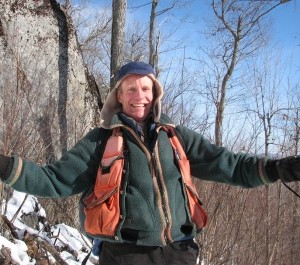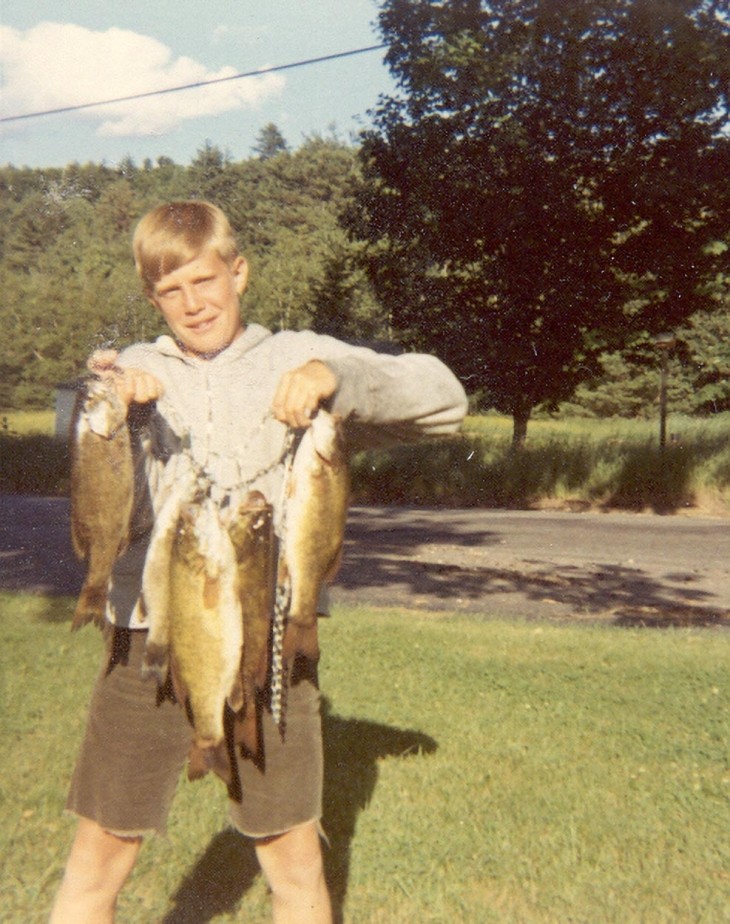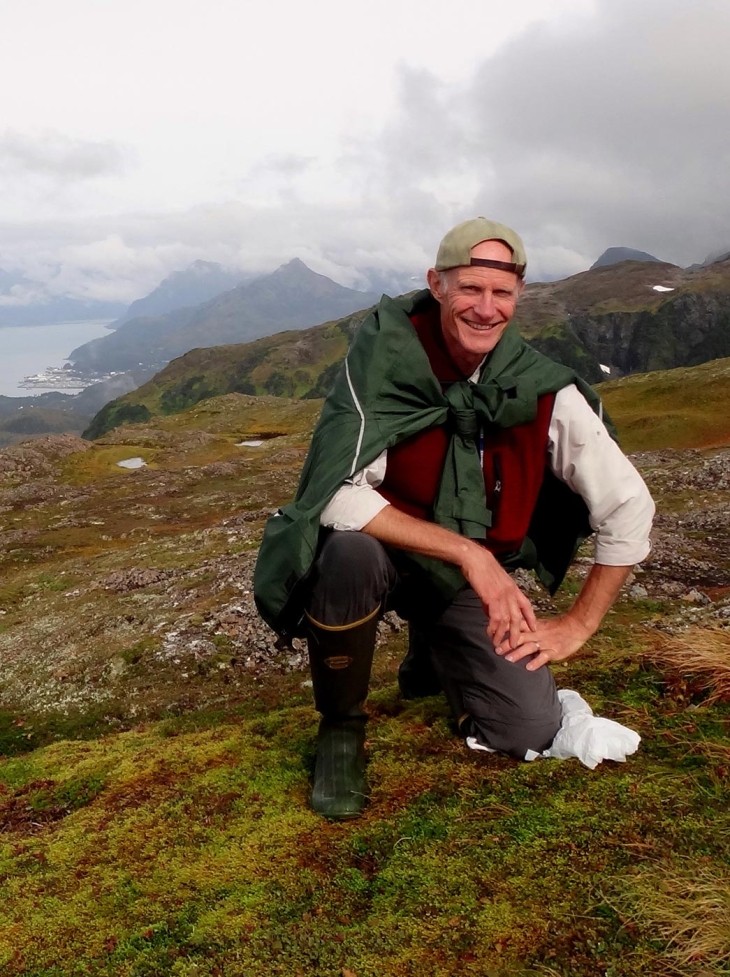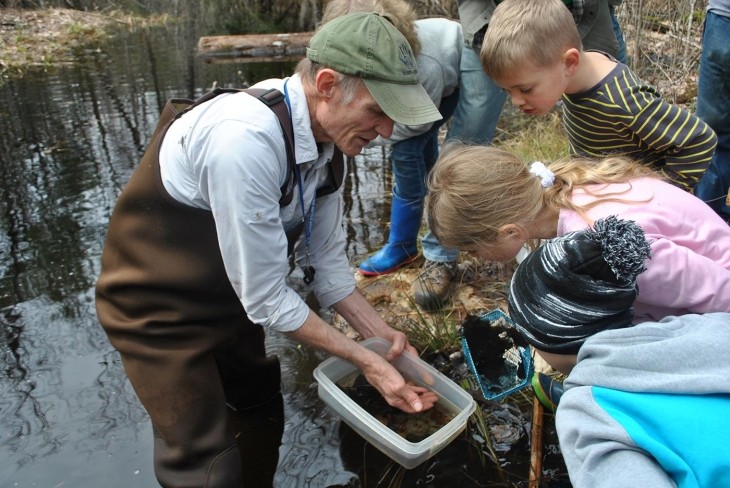
Ecologist Rick Van de Poll’s interests in the forest are as varied as the species that live there. He is a mycologist and a wetlands scientist, a teacher and a mountaineer, a poet and a creator of ecological inventories through the company he founded in 1988, Ecosystem Management Consultants. He spent time in New Hampshire, New York state and New Jersey as a child, in Vermont and Mexico as a teenager, and in Washington, Oregon, and California during his undergraduate and graduate studies. He has hiked the Appalachian Trail, was the founding president of the Northeast Wilderness Trust, and is the Research Director at Tin Mountain Conservation Center. Keenly tuned to the outdoors, he finds there both frustration with the impact of humans’ heavy footprints on the land – and hope in the resilience of nature. Rick lives in Sandwich, New Hampshire, with his wife Wendy and their rescue dog Addie.
I grew up in a few places. The consistent home was my grandparents’ farm in New Hampton, New Hampshire. My parents dropped me off there every summer, every vacation. It was a good place to be. The farm was on the Pemigewasset River – about 150 acres. It was a classic small New England farm. My grandfather had a couple of draft horses, a couple cows, chickens, pigs, a pretty large truck garden, 7 acres of mowing, a bunch of woodlands including sugar maples for tapping.
My grandfather really opened the doors to being out in the woods all the time. We fished, we hunted, trapped – did all the usual stuff that kids do in the country. I didn’t hunt a lot of animals. I think I was 13 or 14 when I stopped. I just wasn’t into eating the groundhog and raccoon and skunk and whatever else we trapped. And I hated defeathering the chickens on the farm. I became a vegetarian when I was 15 and have been ever since.
When I was 4 years old, Route 104 went through the north side of the farm and split it in half. And then in 1966 the highway – Interstate-93 – went right through the farm, north-south, and split it in half that way. That was the end of it for me, in terms of living there and wanting to take it over from my grandparents. It was a first-hand experience of what development does – loss of habitat, loss of farmland. We had prime farmland soils, and we had incredible connections – the old hay path up to the neighbor’s barn was severed. Our water well – we had beautiful clear water and ground water cisterns – that was taken out by the highway. It changed everything. So, that was a heartbreak in many ways, but at the same time an opportunity to really learn about impacts and how the human footprint has changed the environment.
My starting love was birds. I grew up looking at birds. They just fascinated me. When I went to Middlebury College, they didn’t have environmental classes, so I went out every day birding. Middlebury wasn’t an environmental school back in the ’70s. The closest thing they had was geology, and that had 26 prerequisites. So I dropped out. I traveled. I lived in Mexico for six months, learned Spanish, then traveled up the West Coast of the US and ended up at Evergreen State College in Washington. The night I arrived at Evergreen, Willi Unsoeld gave his annual slideshow on his Everest expedition. Willi was this icon, one of the big names in mountaineering. I was in awe. Right then and there, I said, “I’m coming right back here to go to school.”
At Evergreen, you get to create your own education, basically. The first and second year I was there, I did a total independent study on Native American studies and basically learned about the western Salish Tribes and lived with them. I had met Mary St. Hilaire, who was the first western Salish person to get a PhD in the Washington University system. Mary could tell I needed some guidance and help, so she took me in. I studied with her for a solid year. Twice a week we had a meeting of all the Salish people in western Washington who felt disenfranchised and needed to connect with someone who could help solve problems – whether it was fisheries, losing their salmon runs, the logging that was taking place illegally on tribe land. There were a lot of issues that we dealt with. I was the token white guy, so I had a pretty good enrichment experience that year.
Years later, I discovered that my grandfather had Native blood. He always had Native artifacts. He had a stone adz, he had a drum and arrows and a bow and a number of things. I used to ask him about it, but he never would talk about it. When he died, my grandmother showed me a picture of his family. His grandmother was Blackfeet. His grandfather was a homesteader in Kansas. In recent years, we’ve had this whole resurgence of attention on Native American culture – sort of honoring and respect, and the statements that all these nonprofits have added to their calling cards and websites. I think it’s great, but it’s frustrating, because the way that we have treated the environment has really been quite disturbing.
My last year at Evergreen I focused on outdoor education. Nine of us created this program for the year and solicited faculty, and we put out an application for the course to all the other students. We reviewed students; we only accepted them into the program if they met certain criteria. We had 45 students in this group. We did mountaineering, kayaking, boating, ecology work, and wilderness expeditions. We each taught each other our various skills, and I learned how to get good at teaching other students.
I started teaching as an assistant professor at Lane Community College in Oregon the year after I graduated. I taught with a gentleman by the name of Freeman Rowe. Freeman taught a class on the natural history of Baja California. He needed somebody to help him teach, and I spoke Spanish. We brought students down to Baja for three weeks as a natural history class. I also taught Wildflowers of Western Oregon with him. Then I taught through the California School of Herbal Studies, and again we did natural history seminars in Baja California. I spent a lot of time down in Baja. It was a complete wilderness area at that time.
I was committed to doing ecology work, and I got my second master’s, in environmental communications, at Antioch University in Keene, New Hampshire. Having New Hampshire roots, it was easy for me to move back to Keene. The first night I was back from the West, I met Wendy, and we’ve been together ever since – almost 40 years now. When I started at Antioch, I had a master’s degree from San Francisco State. I didn’t have a teaching degree, but I could teach at Antioch with guidance from one of the faculty members. So I started teaching mycology and flora and within a couple of years I was full time. I taught at Antioch for 15 years.
I’ve dedicated myself to be of service to the planet, and that’s something I’ve done since I was old enough to know any different. That all has to do with what I grew up learning – how to respect the land we walk on and not leave footprints. And if we leave a footprint, be intentional about it. Know exactly what that means. That’s just not how our society lives right now. I thought, if I teach, I can get people to actually understand more about their impacts on the planet. And if I teach with direct experience in the environment, people who have those doors open up will actually go on to not only work in the environment, but teach about the environment. I’ve taught about 30 different courses at the undergraduate and graduate level. Mycology, botany, wildlife sampling, natural resource inventory, lichenology, non-flowering plants, alpine flora, wetland science, plus place-based courses in the Pacific Northwest, the desert southwest, Florida everglades, pine barrens of New Jersey, Minnesota Boundary Waters, Galapagos Islands, and the Italian Alps.
My dissertation for my PhD in natural resources management was a guide to comprehensive inventory methods for natural resources – so, providing people with tools to actually go out and learn about their backyard. When you buy a new car, you get a manual. When you buy land, you don’t get a manual. They don’t teach you what to do. How to actually learn about the environment so that you understand better what your impact is on the planet – that’s what I’ve devoted myself to. And that’s where natural resources inventories come in. I think I’ve worked in about 140 towns in New Hampshire – helping towns and organizations do town forest management, wetlands mapping, write ordinances. And I’ve continued to teach. I do about 10 or 15 classes and seminars on various topics through the year.
My goal has always been to try to bring the information to the people – and mostly to the government, because the government has the capacity and the power. They’re authorized to pass local ordinances that can apply the stick to the landowner who’s clueless about what his or her impact is on the land. With a natural resources inventory, you’re learning about what’s there and hopefully changing people’s behavior. Incentives are not big in the state of New Hampshire. Most people need to have regulations in order to change their behavior.
I place most of my hope in the natural world. We are just one species on this planet, and we may not survive the upcoming cataclysm that we are creating for ourselves. And that’s OK, because the planet is going to survive. We’ve had five extinction events. We’re engaged in the sixth right now. All of those events did not terminate life as we know it on the planet. Most people that I take out into the woods, they get so excited about the stuff that I’m talking about – whether it’s butterflies I’m netting or mushrooms they’re cooking up for dinner. It almost seems like a distraction, but I look at it as a reconnection back to our roots. If we reconnect back to our roots, then we’re going to feel better. We’re going to be more grounded, we’re going to be more centered, and we’re probably going to be more aware about our actions on the ground. And all of that is a very positive thing, because it contradicts what the news media and the soundbites want to tell us – that the world is going to hell in a handbasket and you have no power to change that, which is pretty depressing.
There’s more potential for doing work in the environmental field than there ever has been. And that’s another optimistic thing. I think anybody who has an interest in the environment can engage themselves, with mentors or teachers. And if you want a job in the environmental field – take your pick. There are great schools with excellent programs now that really help bring young people into that field and give them hope to make a difference.
I was trained as a report writer, and science has been my mainstay. But that is one particular voice, and it isn’t necessarily reflective of the entirety of the voice I have to offer. That’s why I got into poetry. Poetry is a different way of presenting the same information to a different audience, who will understand it in a different way. I’ve self-published two books of poetry so far. Occasionally I do poetry readings. I find that the verbal diction of reading a poem is in many ways so much more impactive on the listener than reading a report. The poem, with the excruciatingly efficient usage of words, I love. A single word can make or break an entire poem. I love the crux, that fulcrum of impression that it offers.
When I was writing the first book, Crossing Paths, my wife challenged me to be disciplined and to write a poem every day. So I did, for 45 days. Every day, I went into the natural world to find something where crossing paths as a theme could be fulfilled. What am I crossing? Is it a path of an animal? Is it a raindrop, a snowflake? There was more than enough material every day. With the second book, Crossing Higher Ground, I wanted to provide a model, almost a metric, for people to understand what climbers do. The book is presented in four parts. The first part is about the approach. You’re approaching a problem, you approaching a mountain, and you’re looking off and sort of surveying in the distance where the mountain is, what it’s all about, what might be possible routes up the mountain. It was a metaphor, basically, for life – the four stages of life, the four stages of climbing a mountain. Each section has poems that relate to that state, from my own personal experience.






Discussion *